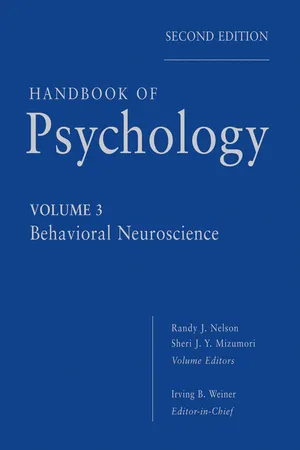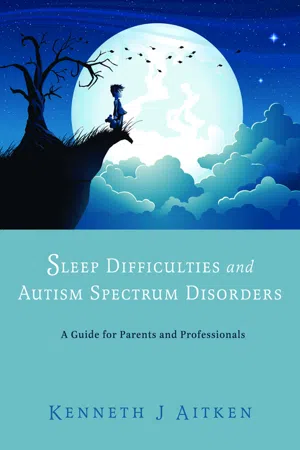Psychology
Sleep and Zeitgebers
Sleep is regulated by internal biological clocks known as circadian rhythms, which are synchronized with external cues called zeitgebers. Zeitgebers, such as light and social cues, help to regulate the sleep-wake cycle by signaling the body's internal clock. Disruptions to these zeitgebers, such as jet lag or shift work, can lead to sleep disturbances and impact overall well-being.
Written by Perlego with AI-assistance
Related key terms
4 Key excerpts on "Sleep and Zeitgebers"
- eBook - ePub
- Amanda Ellison(Author)
- 2012(Publication Date)
- Bloomsbury Academic(Publisher)
9 Just sleep on itOur lives are ruled by rhythm, and I’m not talking about “Dad dancing at weddings” rhythm here. These rhythms take the form of cycles, peaks and troughs of activity throughout the day, month or even year. In the natural world the tide goes in and out every day. Women have a monthly menstrual cycle up until the menopause (menopausal men buy motorcycles). The sleep/wake cycle is generally thought to be our most important daily cycle, and is known as a circadian rhythm. This is the rhythm that gets disrupted if you fly to another time-zone, particularly if you fly east. When everybody is ready for bed, you may be in the middle of the afternoon in your cycle and it takes time to adjust. Our sleep/wake cycle is very constrained to the day/night cycle of the sun and indeed light does control this circadian rhythm. Zeitgebers (meaning time-givers) are environmental events that entrain biological rhythms and light from the sun is our most important Zeitgeber. But what would happen if we lived in a nuclear bunker and we had no light cues at all? What would happen to our biorhythms then?It turns out that in the absence of external environmental cues, we have a perfectly functioning biorhythm, but our sleep/wake cycle would last for 26 hours and not the 24 that we usually have to match the day/night cycle. This endogenous circadian clock seems to be located in the suprachiasmatic nucleus (SCN) of the hypothalamus. If the SCN is disconnected from the rest of the brain, its neurons continue to show fluctuations of neuronal activity that match the circadian rhythm. Damage to the SCN causes animals to continue to eat, drink, exercise and sleep but they do so at haphazard times and so the SCN is not just a biological clock but acts as a pacemaker for other rhythms too. The location of the SCN (see Figure 9.1 ) also explains how light can entrain our endogenous rhythm as it receives direct input from the retina (the retino-hypothalamic pathway mentioned in Chapter 4 - eBook - ePub
- Irving B. Weiner, Randy J. Nelson, Sheri Mizumori(Authors)
- 2012(Publication Date)
- Wiley(Publisher)
In virtually all living organisms, circadian rhythms temporally regulate daily cycles of physiology, metabolism, and behavior. These rhythms are governed by an endogenous timing system that generates robust rhythms even in the absence of environmental input. The most compelling demonstration of this internal generation is the observation that the endogenous period (τ) of this pacemaker, or the rate of cycling of a given rhythm, is remarkably stable in individual organisms under constant environmental conditions. However, without a force to entrain it to the environment, the length of this period is said to “free-run” with a period close to, but not exactly 24 hours (Weitzman, Czeisler, Zimmerman, & Moore-Ede, 1981). The fact that the endogenous clock does not keep precise time when environmental cues are removed implies that regular re-setting is required to ensure that the internal phase, or position, of the organism's clock is temporally aligned with that of the external world. This synchronization is achieved through exposure to a zeitgeber or “time-giver,” which either advances or delays a phase to produce a net daily rhythm shift equal to the difference between the period of the endogenous rhythms (τ) and the period of the zeitgeber. The light-dark cycle is the most potent zeitgeber for the endogenous circadian system, although other nonphotic factors such as food availability, social interactions, and novelty-evoked arousal can entrain the clock or reset circadian phase (Dibner, Schibler, & Albrecht, 2010). The importance of synchronization between the organism and the external environment cannot be overstated; it ensures not only that the organism does the right thing at the right time of day, but also imposes temporal order between the myriad biochemical and physiological systems within the body (Reid & Zee, 2009).The Neural Basis of Circadian Rhythmicity
Richter (1967) reported that large anterior hypothalamic lesions could disrupt the expression of behavioral circadian rhythms in the rat (Richter, 1967). Later studies demonstrated that specific destruction of the suprachiasmatic nucleus (SCN), a set of paired nuclei in the posterior hypothalamus, eliminated circadian rhythms of behavioral and neuroendocrine function in the rat and hamster (Moore & Eichler, 1972; Moore & Klein, 1974; Stephan & Zucker, 1972). A decade later, Menaker confirmed the SCN as the seat of circadian rhythm-generation by transplanting the SCN from a donor animal to an animal whose SCN had been destroyed. Remarkably, the newly restored rhythms in the recipient animal had precisely the same period, phase and amplitude as the donor animal (Ralph, Foster, Davis, & Menaker, 1990). Together, these studies helped to transform the field of circadian biology by defining the SCN as the anatomical structure responsible for keeping internal time. - eBook - ePub
Sleep Difficulties and Autism Spectrum Disorders
A Guide for Parents and Professionals
- Kenneth Aitken(Author)
- 2012(Publication Date)
- Jessica Kingsley Publishers(Publisher)
The similarities in the underpinning biological processes, across the animal kingdom, are allowing significant developments in our understanding of human sleep to be made through the study of its development in other ‘model organisms’ such as Drosophila melanogaster (the fruit fly) and Danio rerio (the zebrafish) (Hendricks, Sehgal and Pack 2000). In addition to sleep–wake cycle issues, mood disorders including unipolar depression and seasonal affective disorder are typically due to abnormalities of the circadian system (McClung 2007; Monteleone and Maj 2008). There is a growing body of evidence that circadian abnormalities are seen in a large proportion of individuals with ASDs (Glickman 2010). Methods for the reliable assessment of human circadian rhythms are now available and in use (see Hofstra and de Weerd 2008). Variations in cognitive ability follow a circadian pattern and are affected both by endogenous circadian clocks and external factors that vary the amount and timing of actual sleep (Kyriacou and Hastings 2010). W HAT IS SLEEP? A useful starting point in understanding and unravelling sleep problems is trying to get a basic idea of what sleep is, why we might do it and what it might be for. We should start by defining what we mean by sleep. There are many definitions to choose from. Here is a selection: Sleep is a reversible condition of reduced responsiveness usually associated with immobility. (Cirelli and Tononi 2008, p.1605) …sleep is that golden chain that ties health and our bodies together. (Thomas Dekker, The Gull’s Hornbook 1609) Sleep is the interest we have to pay on the capital which is called in at death; and the higher the rate of interest and the more regularly it is paid, the further the date of redemption is postponed. (Arthur Schopenhauer) Sleep that knits up the ravelled sleave of care, the death of each day’s life, sore labour’s bath, balm of hurt minds, great nature’s second course, chief nourisher in life’s feast - eBook - ePub
- Michael Eysenck(Author)
- 2014(Publication Date)
- Psychology Press(Publisher)
For example, Michel Siffre spent 7 months in a dark cave. He developed a regular 25-hour sleep–wake cycle, which misled him into thinking he had been underground for several days less than was actually the case. Similar findings have been reported in studies on people spending weeks or months in a bunker or isolation suite (Wever, 1979). Such findings suggest there is an endogenous pacemaker having a period of about 25 hours. Key Terms Endogenous mechanisms mechanisms that are internal and biological and are relatively uninfluenced by external factors. Zeitgeber external events (e.g., light) that partially determine biological rhythms. The above findings are rather odd, because it isn’t clear why we would have an endogenous rhythm differing in length from the 24-hour day we typically experience. In fact, there is an important limitation in the studies, because the participants controlled their own lighting conditions (free-running paradigm). Czeisler et al. (1999) also made use of a forced desynchrony paradigm in which artificial 20- or 28-hour days were imposed on participants, because they couldn’t control the lighting conditions. There was a 25-hour circadian rhythm in temperature with the free-running paradigm. However, the temperature circadian rhythm averaged 24 hours and 10 minutes with both the 20- and 28-hour days. Thus, the endogenous circadian pacemaker has a period of 24 hours, but can be lengthened in artificial environments. The free-running paradigm led to overestimation of the duration of the circadian pacemaker because participants could turn the lights on whenever they wanted. This is important because light is a zeitgeber (literally, The visual pathway in the brain showing the connection to the suprachiasmatic nucleus (SCN) and onward to the pineal gland “time giver”) that partially controls biological rhythms. You probably wake up earlier in the summer than in the winter because you respond to the light outside. Czeisler et al
Learn about this page
Index pages curate the most relevant extracts from our library of academic textbooks. They’ve been created using an in-house natural language model (NLM), each adding context and meaning to key research topics.



